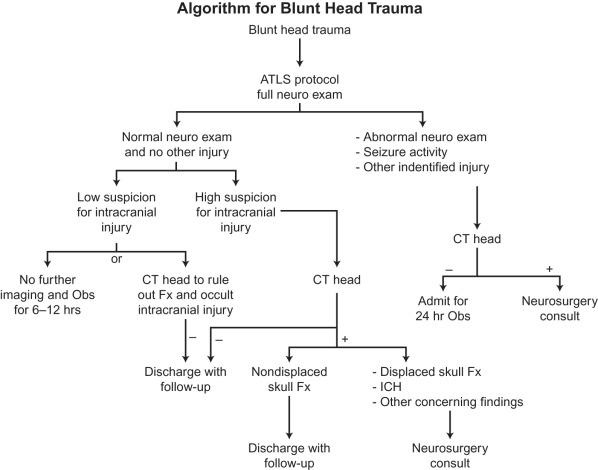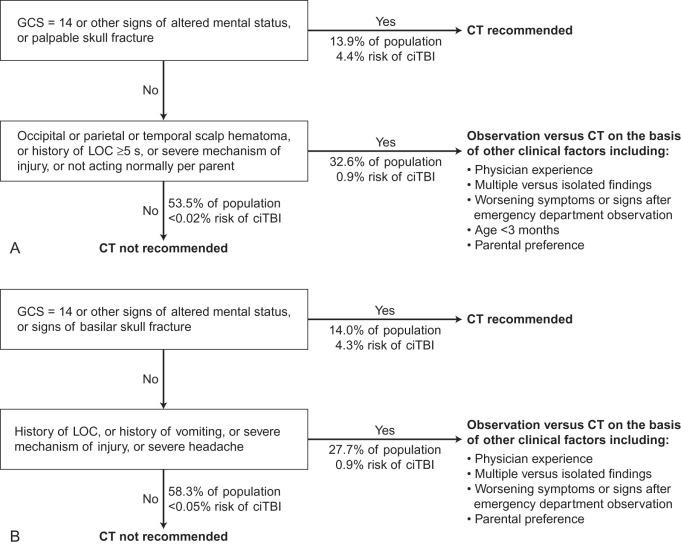Physical Address
304 North Cardinal St.
Dorchester Center, MA 02124
Pediatric head trauma is a major source of morbidity, resulting in 600,000 emergency room visits annually within the United States. Between 10% and 30% of head traumas are associated with calvarial fractures, and of those greater than 50% have neurological injury. While the overall mortality rate from cranial fractures is low (2.9%), cranial trauma still accounts for 7000 deaths per year in the United States. The most frequently cited causes for calvarial fractures that require operative treatment include objects hitting the head (48.2%), followed by falls (13.8%), and motor vehicle collisions (MVC) (10.3%). There are clear sex- and age-associated trends: boys have twice as many calvarial fractures as girls and young children (<5 years) are injured predominantly by falls while older children are more likely to sustain head trauma from collisions and sports.
Among children less than one year of age, nonaccidental head trauma (NAHT) is the leading cause of death. Estimates of the prevalence of NAHT are almost certainly underreported, with studies showing anywhere from 24 to 47 cases per 100,000 children less than a year old. Children suffering from NAHT are predominantly male (61%), less than 6 months of age (55%), and African American (47%). Infants and toddlers with a history of abuse frequently will have long-standing neurological compromise that extends into adulthood. Despite significant effort on the part of practitioners to diagnose NAHT, one study showed that one-third of all cases of abuse go unrecognized. Of the children who belong to the unrecognized NAHT group, four out of five deaths can be prevented by earlier diagnosis of abuse. Children that are discharged with a missed diagnosis of NAHT frequently sustain further abuse, leading to rehospitalization or death. Abuse is missed more frequently in white children than minorities, in two-parent vs. single-parent families, and in children presenting before the age of 6 months, likely secondary to evaluation bias on the part of practitioners.
Diagnosis of nonaccidental head trauma is particularly difficult because the symptoms are nonspecific (vomiting, fever, irritability), the patients are preverbal, and the history surrounding the trauma can be misleading. Furthermore, a false-positive diagnosis of child abuse can cause significant grievance to the family and child and result in dissolution of the practitioner–patient relationship. Several studies have attempted to isolate findings to differentiate nonaccidental from accidental head trauma. A systematic review on clinical and radiographic characteristics associated with pediatric head trauma found that children with NAHT had increased rates of cerebral ischemia, skull fractures, subdural hematoma, retinal hemorrhage, rib and long bone fractures, seizures, apnea at time of presentation, and inadequate or inconsistent histories. Despite these findings, the authors acknowledge the overall nonspecificity of presenting symptoms and history and recommend a holistic and discerning approach to evaluating all cases of pediatric trauma. All patients should be evaluated for bruises on the head and face when they present with nonspecific symptoms such as vomiting, fever, and irritability. Dedicated pediatric radiologists are also better able to discover radiographic evidence of skeletal trauma than nonspecialized practitioners.
Nonoperative management is typically advocated whenever possible for calvarial fractures in children, given the cranium's increased capacity for remodeling and healing at this age. A large retrospective review of 897 children at a Level I trauma center noted that the overwhelming majority of patients with acute skull fractures were managed nonoperatively (86.1%). Of the patients who did undergo operative intervention, more than half did so to address underlying traumatic brain injury. Only 6.5% of all pediatric skull fracture patients had surgical intervention to address the fracture in isolation; the children who underwent surgery did so primarily for depressed or open skull fractures, as well as for frontal sinus fractures or injuries with intracerebral processes.
While there is copious data on management of acute head trauma in adults and children, there is less consensus on management principles for delayed calvarial reconstruction in the pediatric population. Long-term outcomes in managing rare complications such as growing skull fractures or follow-up for nonautologous cranioplasty is lacking. Here we seek to consolidate the evidence supporting indications for pediatric reconstruction, and offer the authors’ management principles in dealing with complex defects.
Pediatric calvarial fractures are classified by pattern (linear or comminuted, depressed or nondepressed, open or closed), and location (flat bone or skull base). Ninety percent of all pediatric skull fractures are linear, and approximately 15%–30% of these are associated with intracranial injuries. Linear skull fractures frequently advance to, but do not violate, suture lines. Most children with linear skull fractures will have overlying subgaleal hematomas ( Fig. 3.2.1 ). Comminuted fractures are a constellation of linear fractures. When found within the occipital or basilar regions, these are particularly concerning for repetitive or NAHT.

Lacerations with associated skull depressions warrant surgical exploration for foreign bodies, cerebrospinal leak, and injury to the dura or underlying brain parenchyma. Depressed skull fractures are commonly associated with intracranial injury (30%) and have an increased incidence of posttraumatic seizure and infection. Some children with depressed skull fractures will present with a palpable bony step-off or bony defect. Depressed skull fractures are clinically significant when displacement of the inner table is greater than one thickness of the bone; 33% of these will have dural lacerations. In the newborn or very young infant, depressed skull fractures are frequently referred to as ping-pong fractures, and can be managed nonoperatively with an obstetrical vacuum extractor. All depressed skull fractures, basilar skull fractures, linear skull fractures with greater than 3 mm diastasis, and fractures with intracranial injury, warrant evaluation by a pediatric neurosurgeon.
Several studies have attempted to risk stratify children who sustain head trauma into those who require hospitalization for observation or further radiological workup. Patients with a normal neurological exam in the setting of head trauma have less than a 5% chance of intracranial injury. Of those, only 1% require neurosurgical intervention. Current guidelines stipulate that children with an isolated, narrow (<3 mm diastasis) linear skull fracture and no focal neurological findings can be discharged without hospitalization. Follow-up studies have shown that this subset of patients is at low risk for complications, but national practices have yet to adopt the recommendations for direct discharge from the emergency room, resulting in avoidable healthcare expenditures. After discharge, the patient should be monitored at home for the first 24 hours following injury, and be assessed overnight for signs of vomiting or decreased arousal. Any neurological symptoms such as increased somnolence, seizure, persistent nausea or vomiting, coordination difficulties, confusion, or visual disturbance, warrants a repeat workup. A recent algorithm published by Blackwood and colleagues for evaluation and management of blunt head trauma (excluding NAHT) is depicted in Fig. 3.2.2 .

In infants, growing skull fractures (GSF), leptomeningeal cysts, or posttraumatic cephaloceles are a group of rare but serious complications that result from traumatic head injury with associated dural tears. Half of all cases are seen in children less than 12 months of age, and 90% of cases are found in children less than 3 years of age. Diagnosis of GSF is frequently missed as it is frequently seen in linear fractures in a closed head injury, and symptoms may present in a delayed fashion. Swelling, cephalhematoma or bony depressions at the site of the defect are also commonly noted. The challenge arises in risk stratifying patients with high probability of developing GSF or leptomeningeal cysts, prior to irreversible brain damage. Clinical presentation of GSF is varied; children can be asymptomatic or profoundly impaired with spasticity, seizures, hemiparesis, or visual disturbances.
Current guidelines for early diagnosis of GSF include the following parameters: (1) age <5 years with cephalohematoma; (2) bony diastasis greater than 4 mm; (3) underlying parenchymal injury; and (4) contrast MRI demonstrating dural tear and brain herniation. Definitive treatment relies on a successful duraplasty and cranioplasty, performed within a month of trauma to mitigate the effects on underlying brain parenchyma. Strict follow-up in patients who are managed conservatively is paramount, with care taken to document new neurological symptoms or an expanding scalp mass.
All pediatric patients with major head trauma require evaluation with a head computed tomography (CT) scan. For children with minor head trauma, current recommendations for ordering a head CT are based off of the Pediatric Emergency Care Research Network (PECARN) guidelines. The PECARN flow-chart is derived from a validated study that identifies children at very low risk of traumatic brain injury using clinical examination findings and Glasgow Coma Scores ( Fig. 3.2.3 ).

In brief, for children younger than 2 years of age, CT radiographs are not indicated if the child has normal mental status, no scalp hematoma, no loss of consciousness (LOC), no palpable skull fractures, has normal behavior, and has a nonsevere mechanism of injury. For children aged 2 years or older, CTs are not indicated for children demonstrating normal mental status, no LOC, no vomiting, nonsevere mechanism of injury, no symptoms of basilar skull fracture, and no headache.
Plain radiographs are not recommended as a screening tool when head trauma is suspected because of their limitations in assessing intracranial injuries. Orman and colleagues demonstrated that 3D reconstruction of CT images increased the sensitivity of diagnosing linear skull fractures in children across age groups. In addition, 3D-reconstructed images also increase the specificity of fracture diagnosis in children under 2 years of age, and where the fracture site is located close to a suture line. For children with suspected basilar skull fractures, a temporal bone CT without contrast with thin sections along the axial and coronal axes is helpful in providing a more nuanced understanding of involved structures.
The role of ultrasound is limited for the same reasons as that for plain radiographs. Namely, while it possesses good sensitivity (88%) and specificity (97%) for fractures diagnosis, it is less reliable in assessing intracranial pathology. Moreover, the technique is highly operator-dependent, and is unreliable in evaluating fractures of the orbital roof. The one area where ultrasound is effective is for screening patients for dural tears as seen with growing skull fractures or leptomeningeal cysts. The dura can be visualized as a bright linear structure through the acoustic window at the fracture site. The absence of a bright signal from the dura is indicative of a dural tear; either CSF or brain parenchyma fills the diastatic space.
For patients presenting for delayed calvarial reconstruction, CT with 3D reconstruction is helpful for evaluating the size, dimensions, and topography of the defect. Furthermore, patient-specific 3D-printed implants can be generated from the posttraumatic CT films and aid in allogeneic reconstruction techniques.
Become a Clinical Tree membership for Full access and enjoy Unlimited articles
If you are a member. Log in here